Fed Faces Critical Decision: Rate Cut or Hold Steady?
28.10.2024 17:00 1 min. read Kosta Gushterov
The Federal Reserve's November 6-7 meeting is expected to determine the course of interest rates, with key inflation and employment data likely shaping the outcome.
Economic indicators released this week may influence the Fed’s decision, with Thursday’s inflation and Friday’s employment reports being closely watched.
Will Stith from Wilmington Trust suggests a high inflation reading combined with a strong jobs report could prompt the Fed to pause, reflecting on the recent 50-basis-point cut.
LPL Financial’s Jeffrey Roach also sees robust job growth as a potential reason for a pause, while others, like Harris Financial Group’s Jamie Cox, predict a 25-basis-point cut regardless of data. Morgan Stanley’s Ellen Zentner anticipates the Fed will cut rates if the job report aligns with expectations.
READ MORE:

JPMorgan CEO Stays Neutral Ahead of Election Amid Speculation on Future Role in Government
The Fed is set to analyze the PCE inflation index, projected to show a slight drop in core inflation, aiming for a 2% target. Meanwhile, the October jobs report could be skewed by recent natural disasters and labor strikes, with 125,000 jobs expected and the unemployment rate steady at 4.1%.
Despite some concerns, EY’s Gregory Dacko anticipates two further cuts by year-end as part of the Fed’s gradual approach to rate adjustments.
-
1
Economic Instability and Political Shift Fueling Bitcoin’s Rise – Galaxy Digital CEO
23.05.2025 12:00 2 min. read -
2
Trump Renews Attack on Fed Chair, Calls for Immediate Rate Cuts
18.05.2025 8:00 1 min. read -
3
Japan’s Inflation Hits 3.5% as Food Prices Soar and Tariff Risks Loom
23.05.2025 21:00 1 min. read -
4
US Dollar Dominance Under Threat Amid Yuan’s Global Ambitions
22.05.2025 14:00 2 min. read -
5
Wall Street Analyst Sees Bright Side of Ballooning U.S. Debt
30.05.2025 8:00 2 min. read
Tariffs Threaten to Stall U.S. Growth in 2025, Recovery Not Expected Until 2026
The U.S. economy may be closer to a downturn than many realize, according to Jay Bryson, chief economist at Wells Fargo.
Dollar Faces Deep Decline as Fed Cuts Pressure Currency, Warns Morgan Stanley
Morgan Stanley has issued a cautionary outlook on the U.S. dollar, predicting a major decline over the coming year as Federal Reserve rate cuts take hold.
Trillions in Debt Payments Could Break U.S. Economy, Ray Dalio Predicts
Legendary investor Ray Dalio has issued a stark warning about the trajectory of U.S. government finances, suggesting the country is drifting toward a series of severe economic shocks unless its debt spiral is urgently addressed.
Wall Street Veteran Warns Tariffs Could Disrupt AI-Driven Market Rally
Steve Eisman, the famed investor known for forecasting the 2008 housing collapse, is sounding the alarm—not on overvalued tech stocks or interest rates, but on the escalating risk of global trade disputes.
-
1
Economic Instability and Political Shift Fueling Bitcoin’s Rise – Galaxy Digital CEO
23.05.2025 12:00 2 min. read -
2
Trump Renews Attack on Fed Chair, Calls for Immediate Rate Cuts
18.05.2025 8:00 1 min. read -
3
Japan’s Inflation Hits 3.5% as Food Prices Soar and Tariff Risks Loom
23.05.2025 21:00 1 min. read -
4
US Dollar Dominance Under Threat Amid Yuan’s Global Ambitions
22.05.2025 14:00 2 min. read -
5
Wall Street Analyst Sees Bright Side of Ballooning U.S. Debt
30.05.2025 8:00 2 min. read

